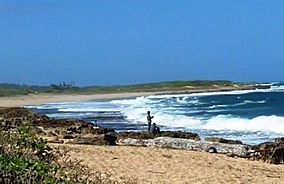James Campbell National Wildlife Refuge facts for kids
Quick facts for kids James Campbell National Wildlife Refuge |
|
|---|---|
|
IUCN Category IV (Habitat/Species Management Area)
|
|
 |
|
| Location | Oʻahu, Hawaii, United States |
| Nearest city | Kahuku, Hawaii |
| Area | 1,100 acres (4.5 km2) |
| Established | 1976 |
| Governing body | U.S. Fish and Wildlife Service |
| Website | James Campbell National Wildlife Refuge |
The James Campbell National Wildlife Refuge is a special protected area on the island of Oʻahu, Hawaii. It was created in 1976 to keep an important natural area safe. This refuge provides a home for many native and traveling animals and plants.
It is a critical habitat for four types of Hawaiian waterbirds that are in danger of disappearing. These include the ʻalae kea (Hawaiian coot), koloa maoli (Hawaiian duck), ʻalae ʻula (Hawaiian gallinule), and āeʻo (Hawaiian stilt). Many migratory seabirds also visit. The refuge also protects endangered plants, the Hawaiian monk seal, and green sea turtle. It helps with flood control for the local community too.
Contents
Where is the Refuge?
The James Campbell National Wildlife Refuge is located at the very northern tip of Oʻahu, Hawaii. It sits between the town of Kahuku on one side and Turtle Bay on the other. This spot is very important for birds that fly long distances. They use it as a landing spot after traveling from places like Alaska, New Zealand, and Asia.
The refuge has two main parts: the Punamano Unit and the Kīʻi Unit. The Punamano Unit is a natural pond fed by a spring. The Kīʻi Unit used to be a marsh but has been changed a lot by farming over time. To keep the Kīʻi Unit wet, water is pumped into seven special ponds. Both parts of the refuge are close to the ocean and are very flat.
Long ago, the Kīʻi Unit was used by the Kahuku Sugar Mill. It helped clean the freshwater for the mill.
Amazing Wildlife and Habitat
The James Campbell Refuge is one of the few remaining wetlands on Oʻahu. It's a very productive place for both local and migratory birds. Some of the special birds you might find here include the kioea (bristle-thighed curlew) and ʻakekeke (ruddy turnstone). Since the refuge started, 119 different kinds of birds have been seen here! Sometimes, unusual birds like the northern harrier or peregrine falcon visit.
There are no native mammals, reptiles, or amphibians that live here naturally.
Challenges for Wildlife
The birds at the refuge face some challenges. Invasive plants and animals can cause problems. For example, avian botulism is a disease that can affect birds. Also, animals like free-ranging dogs, feral cats, rats, American bullfrogs, and the small Asian mongoose can hunt birds and their nests. The refuge works to control these predators to keep the birds safe.
Another issue is that the koloa (Hawaiian duck) can sometimes breed with Mallard ducks. This can change the pure Hawaiian duck population. Invasive plants like para grass and marsh fleabanes can also take over the wetlands. They make it harder for native plants to grow. To manage these plants, the refuge uses controlled burning, changes water levels, and clears them away by hand.
How the Refuge Land is Protected
When the refuge first started, the land was rented from the Estate of James Campbell for 55 years. In 2005, the United States Fish and Wildlife Service bought 222 acres of land. This means they now own it completely. They also bought special agreements called conservation easements for 38 more acres. These agreements make sure the land stays protected.
The Estate of James Campbell planned to sell more land in the area. So, the Hawaii congressional delegation (people who represent Hawaii in the U.S. government) worked with local groups. They wanted to make the refuge bigger. They introduced two bills to expand the refuge to a total of 1100 acres.
Both Congress and the president supported this idea. On May 25, 2006, a law called the James Campbell National Wildlife Refuge Expansion Act of 2005 was passed. This law allowed the refuge to grow and protect even more land.
Visiting the Refuge
Because the refuge is a very sensitive place and not very big, it is usually closed to the general public. This helps protect the animals and their homes. However, you can still visit! Guided tours are offered a few times a week. There are also special events and educational programs. These usually happen between October and February, which is outside the main nesting season for the birds.


